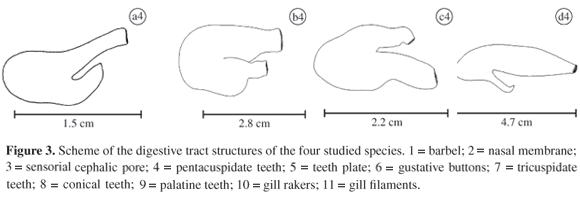The present study is inspired by the great wealth of species exhibited by the ichthiofauna. Not only concepts and techniques of ecology deserve attention, but also knowledge in other biological areas, such as zoology and anatomy, are necessary. The intention of the present work is to discover the morphology of fish through the study of the digestive tract morphology, associating it to diet data, in order to better understand the biology of four fish species of the upper Paraná River floodplain. The samples were collected quarterly in the year 2000 with gillnets of different meshes. The stomach content was analyzed under a stereoscopic microscope and the frequencies of occurrence (FO) and volumetric (FV) and the alimentary index (IAi) were calculated. Various morphologic characteristics were analyzed and schematized using a light chamber. The species were grouped into two trophic guilds - insectivores (Astyanax altiparanae and Parauchenipterus galeatus) and piscivores (Serrasalmus marginatus and Hoplias aff. malabaricus). The first two, although consumers of insects, preyed on different alimentary groups, notably Hymenoptera in the case of A. altiparanae and Coleoptera in the case of P. galeatus. Serrasalmus marginatus and H. aff. malabaricus consumed mainly fishes. However, only pieces of prey were usually found in the stomach content of the first species, whereas whole fishes were found in the stomach content of the second. Astyanax altiparanae exhibited characteristics that allowed it to obtain food in several compartments of the water column. Similarly P. galeatus consumed food resources that were available in all aquatic compartments, although the abilities to capture, to manipulate and to absorb food differed, as shown by the importance of teeth plates and pharyngeal teeth. Serrasalmus marginatus and H. aff. malabaricus, although resembling each other in many aspects of the digestive tract morphology, differed in the strategies used to capture prey. The analysis showed that, according to the main food item of the diet, the species were grouped into two trophic guilds. However, those within the same category used different feeding methods, and similarity in items consumed does not imply the same group of morphological characteristics.
fishes; tropical region; alimentary spectrum; morphology












